To make black color from paints In previous centuries, artists resorted to mixing components of burnt bones or soot, which were the basis of dark matte colors. Today, this color of the dye is made from carbon pigments.
It is believed that black and white colors are achromatic or have no colors or shades. Their only difference is that white completely reflects all radiation, and black absorbs it. Therefore, it is possible to achieve a dark shade by mixing paints in many ways.
Theory of obtaining black color from other colors. Proportions
It is impossible to make pure black, but you can get a shade close to it by mixing paints in the right proportions. To get a color close to black, paints with different compositions are mixed - water-soluble, thick, oil and dyes in solid form.
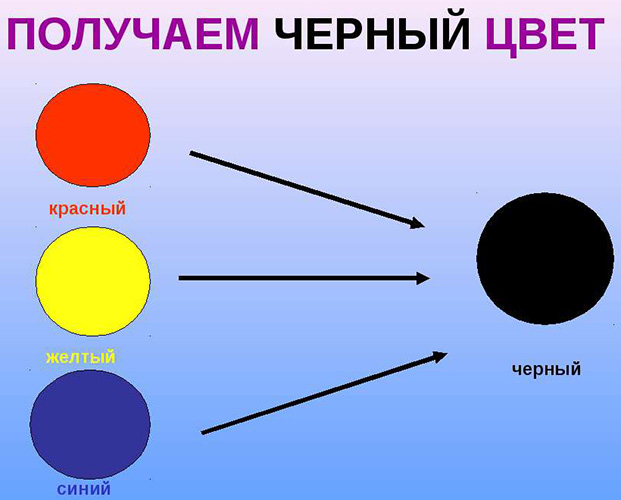
Each pigment may have its own mixing characteristics due to its individual palette, consistency or mixing process.
Regardless of the type of paint chosen, color mixing schemes are considered universal and suitable for any pigments.
| Color scheme | Proportion |
| Bright red + bright green | A smaller amount of green is gradually added to the red pigment. If the colors are mixed simultaneously, the result will be close to brown. |
| Yellow + red + blue | The colors are mixed in equal proportions. One of the colors predominates if a certain shade is needed. |
| Blue + brown | The colors are mixed in equal proportions. The scheme is more suitable for watercolor paints. |
The proportions for each scheme may vary depending on the chosen dye or the desired result. As a result of mixing, soft, medium and rich shades of black can be obtained.

Regardless of the type of paint chosen, the mixing process is approximately the same.
- Prepare the necessary colors for mixing. Select the necessary palette of paints to obtain black.
- Apply paints to the palette individually or at once.
- Mix the paints until the desired tone is obtained.
How to get black color from water-based paints
Making black from water-based or water-soluble paints is easier than from oil-based paints because of their structure, which is easy to mix colors. This process takes less time, but requires careful mixing of all components to eliminate all impurities and inclusions that can affect the final shade.

In general, the process of creating a shade close to black from water-soluble paints consists of the following steps.
- Prepare the component dyes from which the shade will be mixed - red, yellow and blue. By mixing these colors in different proportions, you can achieve a black shade of varying depth.
- Each dye is added to the palette separately in equal proportions to obtain a simple shade of black. To give the desired shade of black, one of the dyes is added in greater quantity. It is recommended to add each new dye to the palette with different brushes so as not to mix the paints. It will be difficult to re-create the desired shade of black, so the required amount of the mixture is mixed at once.
- Mix the paints with a brush for at least 15 seconds to achieve homogeneity. Move the brush in a circle, without pressing it too much into the palette.
- Make a test smear on paper or another surface, wait for it to dry and compare the color saturation with the mixture. If necessary, add the desired dye to the mixture and start painting.
How to get black color from oil paints
Oil paints are more fluid and thicker than watercolor, gouache or acrylic. Therefore, it takes more time to mix the colors of oil paints to get an even tone of the dye. If this is not done, the brushstrokes of the prepared mixture will be applied with inclusions and colored streaks.
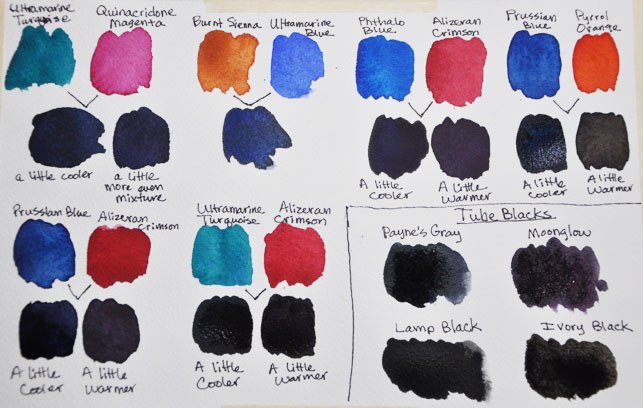
To obtain a black shade, the following pigments are combined with oil paints:
- red with green;
- blue with orange;
- yellow with purple.
Oil dyes are mixed using different methods.
- Manual mixing of paints in one separate container, when the desired colors are picked up with a brush or spatula and mixed until the mixture reaches the desired shade.
- Applying a thin layer of a secondary color over a thick layer of dried paint.
- Optical mixing, where paints are applied to the canvas with a spatula close to each other. From a distance, the colors appear to mix, creating an even tone of a new shade.
How to make black color from gouache paints
Gouache has a thick, quick-drying consistency that is easily diluted with water. The paints have rich shades that are suitable for painting or design work.
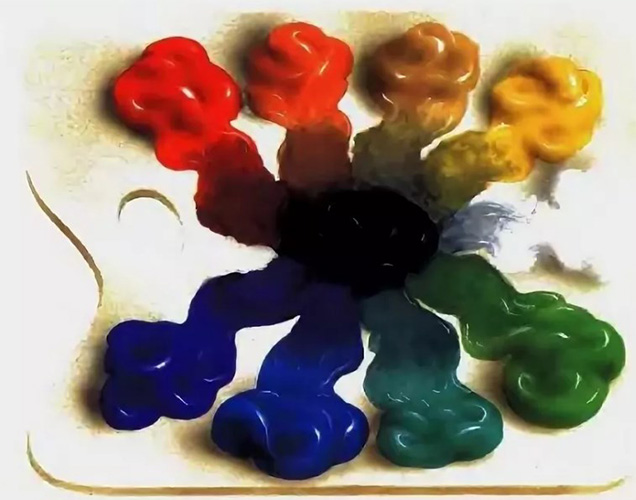
Mix gouache as follows.
- Prepare the necessary paints, brushes, palette or plate, container for water. The palette or surface for mixing colors should be white to avoid optical color change. Choose soft semi-circular brushes.
- The brush is dipped in water, then in one of the paints. Ultramarine is applied to the palette first. The same amount of burnt umber is added to it. The paints are mixed little by little on the palette. Then azure paint is added to deepen the color of the mixture. Do not mix more than 3 different colors at a time, so that the shade does not turn out dirty.
- Make a test stroke on paper or another surface. If necessary, add the necessary paints and repeat the stroke. After drying, gouache becomes lighter, so compare the color of the stroke and the mixture of paints.
- When the finished shade is obtained, they begin painting. If they apply paint to paper, they choose sheets with a rough surface. The first strokes are made vertically, the second ones are applied horizontally, without waiting for the previous layer to dry.
How to Make Black Color with Acrylic Paints
You can make black from paints, such as acrylic or oil, using the same scheme. These are universal, bright and saturated dyes that are used in painting or for decoration.
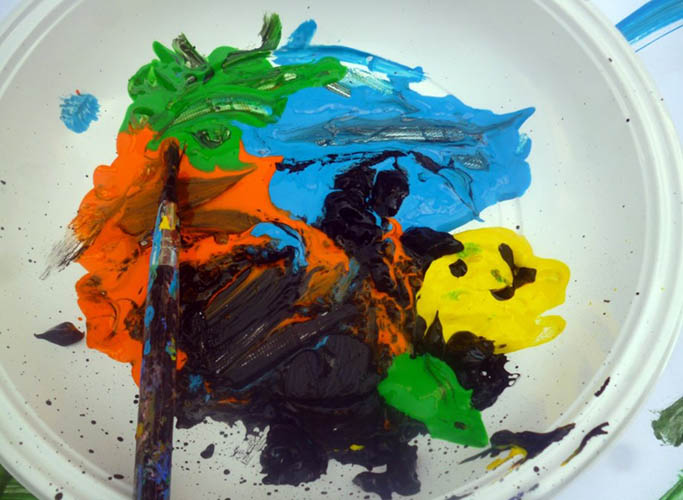
Paints are sold in separate jars, tubes or sets with ready-made color. If there is no black color at hand, its desired shade or it has run out, they resort to mixing several colors from stock.
This happens in the following order.e.
- For mixing, select several colors that will make up the desired shade of black.
- A small amount of the original color is applied to the palette with a brush.
- Add the same amount of secondary color and mix the dyes thoroughly until smooth. If there is a third color in the scheme, add it and mix.
- Make a test stroke of paint on a canvas or other surface and wait for it to dry, since acrylic paints can change saturation after they dry.
- If necessary, add the desired pigment to the acrylic mixture.
- They start painting.
How to make black color from watercolor paints
Watercolor paints are suitable for beginners to work with, as they are easy to use and for mixing several colors. Pigments are combined in case the necessary shade of black is missing or has run out in the main palette.
To do this, follow the algorithm.
- Prepare tubes or briquettes of the desired colors, brushes, paper, a palette, and a container with water in advance. It is advisable to pour water into a large container to keep the liquid clean for as long as possible. Sometimes artists add sugar to the water for additional color saturation. Use a white palette to avoid optical illusions and mix colors only in it.
- The brush is dipped in water, then in the desired paint and applied to the palette recess. Before each time a new color is taken with the brush, the brush is thoroughly washed in water.
- Mix the colors on the palette according to the scheme for obtaining a black shade until the desired result is achieved. Mix the components thoroughly. Try not to mix more than 3-4 colors of watercolor so that the tone is not too dirty.
- If necessary, dilute the paint with water to make the tone less saturated.
- Before painting, make a test stroke on paper to compare the shade with the desired one and, if necessary, adjust the mixture by adding the desired pigment.
How to make black color from plasticine
Black color can be made from thick paints, like plasticine, mechanically, by mixing several types of pigment over a long period of time.
Plasticine can be mixed just like any other paint, but It is not recommended to combine more than 3 colors, so that the mixture does not turn out with an undefined shade.
- Before you start combining different colors of plasticine, you should knead it thoroughly in your hands to warm it up. It is also recommended to soak the material so that it becomes more flexible.
- Mix the additional colors in pieces until you get the desired shade. It is best to mix the colors by kneading them together, then make a roll out of this mass, fold it in half and repeat these movements several times.
- Stir the mixture until the colors combine to a uniform color, which can take up to several minutes due to the thickness of the material.
How to make black color from pencils
Colored pencils are mixed using different techniques – close hatching, color overlay or dots. Most pencils contain wax, which prevents pigments from mixing to homogeneity, so hatching is done in a thin layer. In this case, it is not possible to achieve a pure color, but there is an optical effect.

Mix only pencils of the same type (only wax or only watercolor).
- Apply strokes of one of the colors included in the scheme for obtaining black. All strokes are made in one direction and with a slight pressure so that the saturation can be controlled.
- Shading is done over the first color with additional colors if wax, hard, chalk or pastel pencils are used. All strokes are applied in one direction. Colors are alternated until the desired shade is obtained. The order of application of colors can affect the shade.
- Close shading or dot blending is done if wax and hard pencils are used.
- Once the color is obtained, shading is done with an eraser or a piece of paper. Hard or wax pencils are leveled with a white chalk pencil. Watercolor pencils are leveled with a brush with a small amount of water.
How to make black color from markers
You can make black color from paints in markers or felt-tip pens by mixing no more than 3 colors at a time.
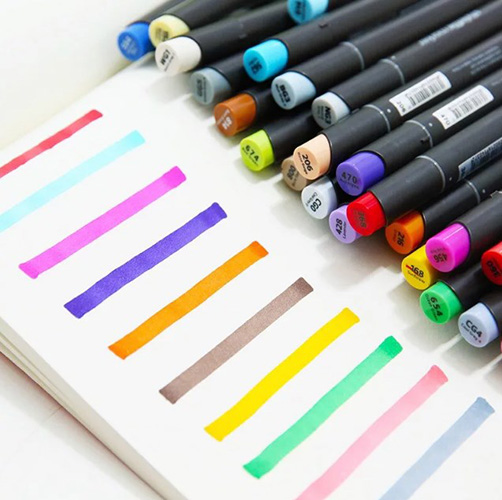
The process of applying markers begins from lighter to darker using circular movements.
- A light tone of the chosen color scheme is applied to the paper to produce black.
- Without waiting for the previous color to dry, apply the remaining colors.
- After drying, the marker color becomes lighter, so make a test mixture on a rough copy.
- Lighten the tone using a zero marker.
- Darken the tone by applying the marker color several times.
Adviсe
To make black from paints with different bases, the same pigments are combined in different proportions or using different methods.
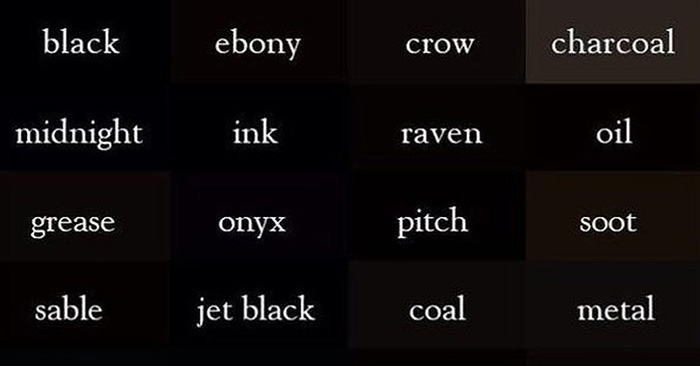
The composition or density of the dye can affect the saturation of the finished color or the length of the mixing process.
- Before you start mixing, it is recommended to put on old clothes or cover the work surface to protect against stains.
- For convenience, all necessary dyes are prepared in advance next to the palette.
- Liquid paints require less time to mix. The thicker the dye material, the longer it takes to obtain a homogeneous mixture.
- Lightening gouache with water removes the color saturation.
- Dried gouache in a jar can be diluted to a semi-liquid consistency with water.
- Gouache covers previous layers well. The new layer does not show through, it can be used to cover up an unsuccessful color.
- The proportions are selected individually due to the changing density of the dye.
- In the glazing method, watercolor is mixed directly on paper using water. The final result is achieved by the optical effect of overlapping shades. First, a diluted tone is applied, wait for it to dry. Another tone of a secondary color is applied on top. Wait for it to dry and so alternate until the desired color is obtained.
- Black color is obtained by mixing all primary colors.
- Adding white dye allows you to get a gray color. The amount of white paint affects the saturation of the gray tone.
- Mixing red with green produces a color that is close to black, but not pure black.
- The closest color to pure black is obtained by mixing yellow, cyan, and magenta.
Video about getting color
How to get black color by mixing paints:
